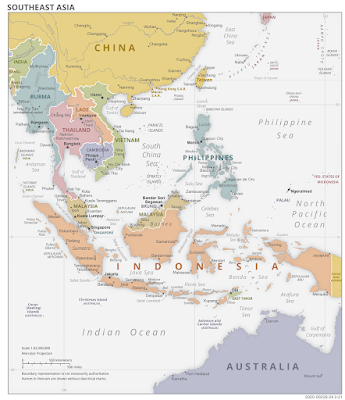Southeast Asia: A Comprehensive Map Guide
Southeast Asia, a region renowned for its rich cultural diversity, breathtaking landscapes and vibrant economies, lies between the Indian Ocean and the Pacific Ocean. The map of Southeast Asia highlights a wide range of nations, each with its own distinct history, geography, and identity. In this article, we embark on a virtual journey through the Southeast Asia map, highlight its captivating features and understand the geopolitical significance of this multifaceted region.
Geographical features
The Southeast Asia map displays a range of geographic features that contribute to the region's uniqueness. From lush rainforests and towering mountains to sweeping beaches and winding rivers, Southeast Asia's landscape is as diverse as it is stunning. The region is divided into two main geographic regions: the continental mainland and the insular region made up of islands and archipelagos.
Mainland Southeast Asia: This region includes countries such as Thailand, Myanmar, Cambodia, Laos, and Vietnam. The Mekong River, a lifeline for many communities, flows through many of these countries, supporting agriculture, transportation and culture.
Insular Southeast Asia: The islands of this region are divided into two archipelagos—the Malay Archipelago and the Philippines. The Malay Archipelago, also known as the Indonesian Archipelago, is the largest island group on Earth, comprising the countries of Indonesia, Malaysia, the Philippines, and Brunei. The archipelago's volcanic landscape, pristine beaches and unique ecosystem make it a biodiversity hotspot.
Major Countries and Capitals
The map of Southeast Asia introduces us to different countries, each with its own individual character, history and cultural heritage.
Indonesia: The world's largest island nation, Indonesia boasts of 17,000 islands. Jakarta, located on the island of Java, serves as its capital and economic center.
Thailand: Known for its ornate temples and vibrant street markets, Thailand's capital, Bangkok, is a bustling metropolis situated along the Chao Phraya River.
Vietnam: Hanoi, the capital of Vietnam, offers a glimpse into the country's rich history and is known for its unique blend of French colonial architecture and traditional Vietnamese landmarks.
Malaysia: Kuala Lumpur, the capital of Malaysia, is a modern city flanked by the iconic Petronas Twin Towers.
Philippines: The sprawling capital city of Manila lies within this archipelagic nation and serves as its cultural, economic and political center.
Historical Significance and Trade Routes
The map of South East Asia is replete with historical significance of centuries. The region was a crossroads of major trade routes that linked East and West, allowing cultures, ideas and economies to flourish.
Maritime Silk Road: Southeast Asia played an important role in the ancient Maritime Silk Road, which facilitated the exchange of goods, technologies and cultures between China, India and the Mediterranean Sea. Ports such as Malacca and Singapore became important trading centres.
Colonial Legacy: The colonial era left an indelible mark on Southeast Asia. European powers such as the British, Dutch, Spanish and French established colonies, which influenced the social, economic and political landscape of the region.
Strategic importance
Beyond its cultural and geographical allure, the Southeast Asia map holds geopolitical significance on the global stage.
South China Sea: This region is at the center of territorial disputes involving countries such as China, Vietnam, Philippines and Malaysia. The region is rich in resources and an important trade route, making it the focus of international attention.
Economic Powers: Southeast Asia is home to emerging economic powers such as Singapore, Malaysia and Indonesia. Their rapid growth and strategic location have made them important players in the global economy.
The map of Southeast Asia is much more than a depiction of land and water; It tells the story of diverse cultures, historical legacies and geopolitical complexities. The region, with its stunning landscapes, vibrant cities and diverse population, is shaping the world in countless ways. As we explore this dynamic geography, we gain a deeper appreciation for the complexities that define Southeast Asia's past, present and future.


Comments
Post a Comment